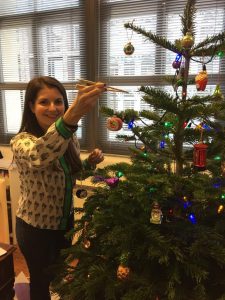
DBA Roundup
A roundup of industry expertise, exclusive resources, business support and tools for your design business.
Packaging plays a key role, with calls for consistent labelling so consumers know what they can recycle.
DBA Chief Executive Deborah Dawton says,
‘I couldn’t agree more with the recommendation to design products that last longer and increase the levels of repair and re-use. This is wholly possible and we have the design talent in this country to do this. Manufacturers need to ask for this, they need to gear themselves up with take-back systems, we need to change our default setting to dispose of broken goods and we need to give birth to a service industry proposition that makes repair feasible and affordable. All possible if everyone plays their part’.










It is widely recognised that ‘80% of the environmental impacts of products and services are determined at the early design stages [EU Ecodesign Directive 2009]. This explains why we must design for sustainability in the first place, rather than making changes at a product’s end-of-life, manufacturing, transportation or sourcing alone. It implicates designers in today’s sustainability problems; but also suggests design will be part of the solution – helping create a new generation of products, services and business models fit for a sustainable future.
Key to good design is a good brief; the all-encompassing blueprint for a successful project usually prepared by clients for their designers. Shaping the brief with clients, as we all know, leads to better, more creative and commercially successful results and designers work hard to convince clients to co-create the brief before all the important decisions are made. Getting sustainability into design briefs is therefore a critical step to successful sustainable design, too.
![]() But it’s ‘pre-brief’ – during the earliest stages – that the most transformational, sustainable design work may be done.
But it’s ‘pre-brief’ – during the earliest stages – that the most transformational, sustainable design work may be done.
When I previously held early stage design positions in design agencies, in futures or strategy roles, we discovered that it was always difficult to add sustainability to projects when a client didn’t specify it in the brief so we did most sustainability work at the front-end. Much great design starts before the brief, with research, insights or strategy work, where there is uncertainty or a high degree of freedom to shape what the new product actually is. This fuzzy front-end, often known as design innovation or strategic design, offers amazing potential for the new generations of products and services we surely need for sustainability.
And businesses like Philips have been leading the field in this respect with their Senior Director of Strategic Design for Sustainability in the role for some 20 years now and that team recently expanded its early stage sustainable design work through a Strategic Design for the Circular Economy role as well. More agencies too are recognising how requisite that fuzzy-front end is to sustainability; much of my recent work supporting design agencies on sustainable design has been either research or strategy to inspire creative workshops or idea generation stages of design.
![]() Inevitably clients will play a critical role in getting sustainability effectively into design briefs, and the good news is that businesses are stepping up on sustainable products and design too. 3M recently joined a long list of companies stating that ‘all new products are to include sustainability’ from 2019 – a roll-call of sustainable businesses and big design buyers that includes M&S, Philips, IKEA, Natura, Nike, Kingfisher, Henkel, P&G, and others, making pioneering commitments to sustainable product design.
Inevitably clients will play a critical role in getting sustainability effectively into design briefs, and the good news is that businesses are stepping up on sustainable products and design too. 3M recently joined a long list of companies stating that ‘all new products are to include sustainability’ from 2019 – a roll-call of sustainable businesses and big design buyers that includes M&S, Philips, IKEA, Natura, Nike, Kingfisher, Henkel, P&G, and others, making pioneering commitments to sustainable product design.
All good stuff, but it should not exonerate designers of their responsibility to promote sustainability in the brief. Granted, influencing our pay-masters or controlling the brief may be easier said than done, yet clients frequently turn to designers for expertise and skills they don’t possess in-house, like digital know-how or user-orientation – why not on sustainability as well?
One obvious barrier to this is the low-level of sustainability literacy in the design community today. In sustainability work supporting design agencies, I often start by asking ‘do you know your clients’ sustainability goals or targets?’, which is frequently greeted with, ‘what sustainability targets?’ I often find sustainability knowledge to be woefully low, with many designers not even aware of the client sustainability programmes, having no idea about the basics of bioplastics or recycling/recyclable/recycled content, etc. This is worrying if we want to take sustainability to the early stages.
The Intergovernmental Panel for Climate Change delivered the most important point of no return for humanity recently, telling us we have just 12 years to curb runaway climate change. Designers often work on timeframes of 1-3-5-7 years, meaning future projects will be launched into this increasingly climate constrained world – we must start thinking about this now.
Let’s all make a commitment to front-up on sustainability in 2019, and influence those opening, strategic conversations with clients to get sustainability considered early-on.










 Who are your top five advocates? Give them a ring and arrange to meet up in the new year (your existing network is always the fastest route to new revenue). Got this covered? Who in your network are to be your next five advocates? Now give them a ring.
Who are your top five advocates? Give them a ring and arrange to meet up in the new year (your existing network is always the fastest route to new revenue). Got this covered? Who in your network are to be your next five advocates? Now give them a ring.
Lucy Mann, Gunpowder Consulting
 Best advice for the rest of 2018? Breathe, relax, smile, laugh, have fun. And for 2019? Exactly the same. Yes, it will be an unsettling year ahead politically, but if you don’t actively put enjoyment into life, your work will suffer and so will your business. Make time for it.
Best advice for the rest of 2018? Breathe, relax, smile, laugh, have fun. And for 2019? Exactly the same. Yes, it will be an unsettling year ahead politically, but if you don’t actively put enjoyment into life, your work will suffer and so will your business. Make time for it.
Shan Preddy, Preddy & Co
 Not only will well-crafted storytelling open new avenues to market communications, it’s also one of the most effective means of building strong and committed teams. Encourage staff members to share their best – or worst – experience of the week when you meet over Friday afternoon beers and carry it on into 2019. It really works…
Not only will well-crafted storytelling open new avenues to market communications, it’s also one of the most effective means of building strong and committed teams. Encourage staff members to share their best – or worst – experience of the week when you meet over Friday afternoon beers and carry it on into 2019. It really works…
Steinar Valade-Amland, Three Point Zero
 Winning the new business you want next year is also about clearing out the clients /projects that take up too much resource for too little reward. Have a team discussion about what work conflicts with your future aspirations. Resolve to act in the new year: close them out, let them go, create space for what you want to do instead.
Winning the new business you want next year is also about clearing out the clients /projects that take up too much resource for too little reward. Have a team discussion about what work conflicts with your future aspirations. Resolve to act in the new year: close them out, let them go, create space for what you want to do instead.
Lynne Elvins, Design Rally
 Small improvements over the whole of a business can lead to increased margins, often with no increase in cost. Whether it be charging for that extra half hour of project management time on every project or renegotiating the utility bills, draw up a list of small improvements you could make in 2019 to impact your bottom line.
Small improvements over the whole of a business can lead to increased margins, often with no increase in cost. Whether it be charging for that extra half hour of project management time on every project or renegotiating the utility bills, draw up a list of small improvements you could make in 2019 to impact your bottom line.
Chris Lang, Flash Accounts
 As the year ends, ask your employees what they are longing to learn in 2019. Then, make a commitment to support them achieving their goal. Helping others better themselves is the most precious gift you can give; better than a salary increase or title. They will be forever grateful.
As the year ends, ask your employees what they are longing to learn in 2019. Then, make a commitment to support them achieving their goal. Helping others better themselves is the most precious gift you can give; better than a salary increase or title. They will be forever grateful.
Roberta Ronsivalle-Pearce, Namah & Partners
 Ask your clients to write down three things they like most about the consultancy and three things they’d change on Christmas tags. Hang the tags on the tree for all to see. As well as a talking point, you have the start point for your New Year’s resolutions.
Ask your clients to write down three things they like most about the consultancy and three things they’d change on Christmas tags. Hang the tags on the tree for all to see. As well as a talking point, you have the start point for your New Year’s resolutions.
Adrian Day, Day Advisers
 Spend half a day prior to your Christmas party to assess the successes you’ve had through the year – your wins and traction. Devise and plan a new ‘test and learn’ campaign to drive momentum in the new year. Boost off 2019 with an approach that deeply connects with your audience(s).
Spend half a day prior to your Christmas party to assess the successes you’ve had through the year – your wins and traction. Devise and plan a new ‘test and learn’ campaign to drive momentum in the new year. Boost off 2019 with an approach that deeply connects with your audience(s).
Natasha Ellard-Shoefield, The Hand
This the season of good cheer
but what of your plans for next year?
Brands are facing one helluva storm,
packs on the shelf no longer the norm.
How to help them?
How to attract?
An architect once said..
“it’s not possible to go forward,
whilst looking back”
Nick Gray, Mr Gray Branding
 Make a commitment to read a book a week in 2019. Spend 30 minutes before Christmas to compile a book list for quarter one. Learn about the world beyond your day to day, as well as reading books that directly relate to your day to day. As your brain fills, be stimulated into action and apply the learnings and contexts into your working life.
Make a commitment to read a book a week in 2019. Spend 30 minutes before Christmas to compile a book list for quarter one. Learn about the world beyond your day to day, as well as reading books that directly relate to your day to day. As your brain fills, be stimulated into action and apply the learnings and contexts into your working life.
Jeremy Paterson, IF Media Consultancy
 In the season of peace and goodwill to all, it’s still too easy to only contact this year’s successful clients. How about contacting the ones who didn’t award you work, or did but it didn’t run smoothly? Rebuild a bridge with them, elicit some candid feedback and see how that can inform your strategy for next year.
In the season of peace and goodwill to all, it’s still too easy to only contact this year’s successful clients. How about contacting the ones who didn’t award you work, or did but it didn’t run smoothly? Rebuild a bridge with them, elicit some candid feedback and see how that can inform your strategy for next year.
Andy Cripps, Andy Cripps Design Management
 Getting your team to switch off from work and enjoy some quality time with their friends and family can’t be underestimated. Thanking your team for all their hard work and giving them a glimpse at what’s in store for 2019 will also improve motivation and give them a sense of purpose for the new year.
Getting your team to switch off from work and enjoy some quality time with their friends and family can’t be underestimated. Thanking your team for all their hard work and giving them a glimpse at what’s in store for 2019 will also improve motivation and give them a sense of purpose for the new year.
Aliya Vigor-Robertson, JourneyHR
Work out your vision for 2025…. It’s the magnet that pulls you.
Brain storm your core values:
Focus on your core skills.
Work out your three-year plan.
Break it down into 90 day markers.
Get very clear on your: people, processes, issue resolution, data analysis
Gary Baxter, Lightbox Consulting
 You may already know that you can spend £150 pa (inc Vat) per employee on a staff party without reporting this to HMRC. But did you know you can also give staff £50 of tax-free gifts under the Trivial Benefits scheme? A voucher or a bottle of drink could apply, but remember it can’t be linked to the employee’s performance.
You may already know that you can spend £150 pa (inc Vat) per employee on a staff party without reporting this to HMRC. But did you know you can also give staff £50 of tax-free gifts under the Trivial Benefits scheme? A voucher or a bottle of drink could apply, but remember it can’t be linked to the employee’s performance.
Julian Davies, Redfin Management
 Now is time to reflect on what was good and bad in 2018. Did your standard contract paperwork do its job? If it did keep it, but if it did not review it and change or start again. Merry Christmas!
Now is time to reflect on what was good and bad in 2018. Did your standard contract paperwork do its job? If it did keep it, but if it did not review it and change or start again. Merry Christmas!
Darrell Stuart-Smith, Humphries Kirk
 Compile three lists of contacts – current clients, ex-clients, people you know. These people are your greatest new business asset so make a real commitment to cherishing this asset in 2019. Communicate with them regularly, share relevant knowledge, make them feel valued. Do this consistently and your asset will bear fruit.
Compile three lists of contacts – current clients, ex-clients, people you know. These people are your greatest new business asset so make a real commitment to cherishing this asset in 2019. Communicate with them regularly, share relevant knowledge, make them feel valued. Do this consistently and your asset will bear fruit.
Jonathan Kirk, Up to the Light
 Firstly, celebrate all the wins, big or small, that you’ve achieved as an agency over the past year. Then commit to celebrating small achievements every day in 2019. Doing this can enhance motivation, boost confidence and guide your agency towards greater success.
Firstly, celebrate all the wins, big or small, that you’ve achieved as an agency over the past year. Then commit to celebrating small achievements every day in 2019. Doing this can enhance motivation, boost confidence and guide your agency towards greater success.
Catherine Allison, Master the Art
If you have a particular business challenge or are looking to move your agency to the next level, we’ll work closely with you to connect you to an expert, whatever the issue. We’ve identified expert consultants with sustained and relevant experience in supporting the design industry, so you can rest assured that we can introduce you to the right one to meet your needs.
Read about all of the DBA Experts.
Image credits:
MARIA-MEKHT on Unsplash
YIFEI CHEN on Unsplash
Scott Webb on Unsplash
YIFEI CHEN on Unsplash
Melissa Askew on Unsplash
Jungwoo Hong on Unsplash
Samuel Holt on Unsplash
Mel Poole on Unsplash
Ria Puskas on Unsplash
Denys Nevozhai on Unsplash
Yutacar on Unsplash
Robert Zunikoff on Unsplash
Elena Koycheva on Unsplash
Caleb Woods on Unsplash










Blockbuster, Kodak and now Toys “R” Us: Brands that couldn’t keep up with the pace of change. Blinded by their own success and ignorant to new opportunities, they dismissed change in favour of the familiar – quickly becoming irrelevant.
If we’re not doing anything new, we’re not competing – just keeping up. Technology, behaviours and creativity are evolving daily. If we don’t do something new, someone else will. They’ll be the ones to move the category forward. They’ll be the ones to own new standards. They’ll be the ones to create the change that matters.
The tremendous and the terrifying of what could be.
It’s a catalyst for us, our industry and the people we work with to think ahead.
To understand the future and confirm our place in it.
We’ve outlined key themes that will undoubtedly change our future.
And we’ve used this as a basis to imagine what’s next.
So we can prepare, achieve and avoid.
Staying relevant and ready.

Autodraw, SquareSpace, MarkMaker.
It’s easy to turn up our noses and pretend they’re not a threat.
But these are just the start.
Automation is coming, but that doesn’t mean we’re screwed.
Car manufacturers are using AI to design cars in ways humans couldn’t dream.
How can we use it to elevate our roles and strengthen our outputs?

Data shows us that personalisation works.
The ways and means to personalise are only getting stronger.
But also more invasive.
Facial recognition, mood sensors and mind readers.
Companies like Facebook and Google are pushing the limits of data privacy.
Will it go too far? Has it already?
How will we shift the power back to the people?

Augmented reality is only in its infancy.
But the rewards of embracing it now could be boundless.
Surgeons are already using it to help save lives.
With the line between physical and digital ever blurring, augmented reality is inevitable.
Our screens restrict us to the flat and disconnect us from reality.
Augmented tools will change everything.
How will we take steps to integrate it into our process?

Big data is only getting bigger.
More and more information is helping agencies target better.
However, we need to balance this with empathy.
Understanding our audiences on an emotional level.
Not only tracking how they act, but how they feel.
How will we get closer to people?

Working behind closed doors, waiting for the ta-da moment.
Whilst it’s a nice feeling, it’s not mutually beneficial.
Hidden information leads to scepticism.
Creative ownership leads to friction and polarising outputs.
We need to embrace a culture of shared thinking with our clients and our peers.
How will we open up our entire process?
The future is full of opportunity, but only if we seize it.
If we predict it.
And design it.
This is just the beginning.
Find out more about The Future Agency App.
Image credits: Uniform










 Christmas Reeve is getting in the groove while she bakes a cake or two with this seasonal playlist on Spotify… Four hours and 43 minutes of pure festive joy. Why not take a listen?
Christmas Reeve is getting in the groove while she bakes a cake or two with this seasonal playlist on Spotify… Four hours and 43 minutes of pure festive joy. Why not take a listen?
 Lassie Lukins’ Christmas tip: Need help faking your reaction to your pressies….
Lassie Lukins’ Christmas tip: Need help faking your reaction to your pressies….
…Watch this

Sushi-powered Papa has the answer to no-hassle mulled wine:
“My recipe for mulled wine is a little non-traditional but I have been known to mix this fancy little number with red wine for a no-hassle mulled wine in a hurry. With an added cinnamon stick for authenticity, of course.”
 Deborah is taken to colourful flights of fancy, but this perfect winter warmer is easy to do and if you follow her recipe in 3 months time, you’ll be everyone’s best friend!
Deborah is taken to colourful flights of fancy, but this perfect winter warmer is easy to do and if you follow her recipe in 3 months time, you’ll be everyone’s best friend!
400g elderberries, 750ml gin, lemon peel, 150g of sugar, and 1L Kilner jar.
 Ramiro loves his food and he’s missing his traditional Venezuelan Christmas tucker, most especially ‘Hallacas’ – a tasty mixture of beef, pork, chicken, capers, raisins, and olives that is wrapped in maize and plantain leaves and tied up with string into a parcel and then boiled or steamed afterwards.
Ramiro loves his food and he’s missing his traditional Venezuelan Christmas tucker, most especially ‘Hallacas’ – a tasty mixture of beef, pork, chicken, capers, raisins, and olives that is wrapped in maize and plantain leaves and tied up with string into a parcel and then boiled or steamed afterwards.
 Celebrating her new role at the DBA this month, Jess suggests wrapping presents as you buy them rather than facing down the horror of a midnight wrapping session on Christmas Eve, when all you really want to be doing is sitting in front of the telly/fire/both with a large Baileys.
Celebrating her new role at the DBA this month, Jess suggests wrapping presents as you buy them rather than facing down the horror of a midnight wrapping session on Christmas Eve, when all you really want to be doing is sitting in front of the telly/fire/both with a large Baileys.
Adam thinks Poffertjes – mini dutch pancakes served with icing sugar and toffee sauce – are definitely something to write home about. Search them out at a Christmas Market near you or check out this recipe. 
 Hoping for a white Christmas, Hannah suggests hot-footing it to one of the National Trust properties and taking part in their many festive activities, like at this urban gem.
Hoping for a white Christmas, Hannah suggests hot-footing it to one of the National Trust properties and taking part in their many festive activities, like at this urban gem.
“Meet Santa, discover the wetlands boardwalk on a frosty morning, take a festive carriage ride around the park and check out Psycho the fish at the aquarium – he has to be seen to be believed.”
 Comms Queen Clancy’s (and her Corgi’s) top tip is to check-out the art galleries and museums gift shops online.
Comms Queen Clancy’s (and her Corgi’s) top tip is to check-out the art galleries and museums gift shops online.
“My favourite is the Royal Academy’s where you’ll find a treasure trove of wares – from jewellery to books and of course christmas cards and decorations – handcrafted and designed by artists, including Royal Academicians themselves. Pick up something unique and support the UK’s cultural institutions at the same time!”
From all of us at the DBA, wishing you a merry Christmas and a happy New Year!
See you in 2019 for a year packed with activity that will continue to champion British design, and support you, your team and your business.










Government has traditionally measured enterprise growth by either turnover or headcount. The CIF report – which draws from survey responses from 1000 creative enterprises – has found that although “Turnover was an important measure of growth for many creative enterprises,” most also stressed that other factors such as “increased profile and social impact” were also fundamental.
“Many design businesses view social impact as integral to the success of both their own businesses and their local supply chain,” DBA CEO Deborah Dawton is quoted as saying in CIF’s report, before adding that, “in practice this can take the form of contracting with local suppliers and freelancers, mentoring smaller businesses in their supply chain and investing in the next generation of talent.”
DBA members have really embraced this and have been sharing details of their inspiring projects at the networking event series the DBA has held for its members up and down the country this year. These events – alongside an extensive programme of training workshops – have been helping our members to positively shape their future by recognising and nurturing within their own businesses the unique characteristics that define our industry and set it apart.
The creative industries are the fastest growing sector in the UK economy. The potential for future growth is clear. But as the CIF report has found, in unlocking this the more complex picture and nuances of creative enterprises must be taken into account in any policy-making and business support targeted at creative industries.
There is also a “fear that the UK will fail to prepare the next generation for the future of work, where creative skills will be crucial across all industries” found CIF. In October, the DBA together with the All-Party Parliamentary Design and Innovation Group (APDIG), the Design and Technology Association (DATA) took steps to actively engage government and policy makers in addressing these issues. Together we jointly launched a report that sets out recommendations for how design can be embedded within our education system to equip the next generation with the skills required to confidently face the challenges of the Fourth Industrial Revolution. At the launch, Deborah spoke of the fatigue with the idea of pitting academia and design against each other.
“Why is it that academia is the first option, and students who don’t excel in that are filtered into creative subjects? In the economy and society of the future, creativity and creative skills will be the skills that aren’t automated. Let’s flip the argument on its head and give creativity the same footing as academia. The DBA is calling for equality of opportunity through a fair and equal education system where students have a fair choice of what they study.”
In looking at the challenges creative enterprises face, CIF found that many – particularly micro businesses and freelancers – “were not undertaking enough measures to protect and exploit their IP, and were unaware of the growth opportunities that exporting their services/products might deliver.” The reasons cited for this were “primarily that both IP and the process of exporting – particularly something intangible – are complex landscapes that take time and money to navigate and get right”.
And yet Creative businesses with higher turnovers were three times more likely than those on lower turnovers to attribute their turnover growth to expanding internationally (including exporting). This is a pattern we saw in the DBA’s 2018 Annual Survey Report which indicated that the businesses with the highest fee income, were most likely to derive a greater proportion of their income from overseas work.
That’s why a priority for DBA in the coming years is to support members in expanding their reach internationally and it’s why the DBA’s CEO heads the design mission on the Creative Industries Trade and Investment Board (CITIB), which has a goal to increase exports by 50% by 2023.
And when it comes to protecting IP our members benefit from legal guidance as part of their membership. Because, as the CIF report recognises – membership organisations like the DBA can offer a wide range of practical, uniquely tailored support for their sector.
In CIF’s survey, the majority of creative enterprises (80%) indicated that the support they had accessed from the likes of finance providers, lawyers and membership trade bodies, was either “crucial to business growth” or “played a partial role in business growth”. And yet the report also discovered that only a quarter of creative enterprises access support from a trade body.
From our flagship-mentoring scheme, to our library of resources, business support helplines, register of industry specific Experts, and much more, we can fast track you to the support you need to grow your business.
So if you are a member make sure you’re making the most of our services and always feel free to pick up the phone to find out how. And if you’ve not yet joined, we’d love to hear from you about how we can support you and meet your needs.
Contact our membership team to discuss how we can help your design business grow.
P: 0207 251 9229









